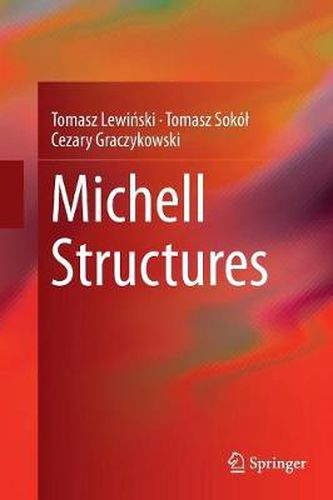Readings Newsletter
Become a Readings Member to make your shopping experience even easier.
Sign in or sign up for free!
You’re not far away from qualifying for FREE standard shipping within Australia
You’ve qualified for FREE standard shipping within Australia
The cart is loading…






This title is printed to order. This book may have been self-published. If so, we cannot guarantee the quality of the content. In the main most books will have gone through the editing process however some may not. We therefore suggest that you be aware of this before ordering this book. If in doubt check either the author or publisher’s details as we are unable to accept any returns unless they are faulty. Please contact us if you have any questions.
The book covers the theory of Michell structures being the lightest and fully stressed systems of bars, designed within a given domain, possibly within the whole space, transmitting a given load towards a given support. Discovered already in 1904 by A.G.M. Michell, the structures named after him have attracted constant attention due to their peculiar feature of disclosing the optimal streams of stresses equilibrating a given load and thus determining the optimal layout of bars. The optimal layouts emerge from among all possible structural topologies, thus constituting unique designs being simultaneously light and stiff. The optimal structures turn out to be embedded in optimal vector fields covering the whole feasible domain.
Key features include: a variationally consistent theory of bar systems, thin plates in bending and membrane shells; recapitulation of the theory of optimum design of trusses of minimum weight or of minimal compliance; the basis of 2D Michell theory for a single load case; kinematic and static approaches; 2D benchmark constructions including Hemp’s structures and optimal cantilevers; L-shape domain problems, three forces problem in 2D, bridge problems; revisiting the old - and delivering new - 3D benchmark solutions; extension to multiple load conditions; Prager-Rozvany grillages; the theory of funiculars and archgrids; the methods of optimum design of shape and material inspired by the theory of Michell structures, industrial applications.
The book can be useful for graduate students, professional engineers and researchers specializing in the Optimum Design and in Topology Optimization in general.
$9.00 standard shipping within Australia
FREE standard shipping within Australia for orders over $100.00
Express & International shipping calculated at checkout
This title is printed to order. This book may have been self-published. If so, we cannot guarantee the quality of the content. In the main most books will have gone through the editing process however some may not. We therefore suggest that you be aware of this before ordering this book. If in doubt check either the author or publisher’s details as we are unable to accept any returns unless they are faulty. Please contact us if you have any questions.
The book covers the theory of Michell structures being the lightest and fully stressed systems of bars, designed within a given domain, possibly within the whole space, transmitting a given load towards a given support. Discovered already in 1904 by A.G.M. Michell, the structures named after him have attracted constant attention due to their peculiar feature of disclosing the optimal streams of stresses equilibrating a given load and thus determining the optimal layout of bars. The optimal layouts emerge from among all possible structural topologies, thus constituting unique designs being simultaneously light and stiff. The optimal structures turn out to be embedded in optimal vector fields covering the whole feasible domain.
Key features include: a variationally consistent theory of bar systems, thin plates in bending and membrane shells; recapitulation of the theory of optimum design of trusses of minimum weight or of minimal compliance; the basis of 2D Michell theory for a single load case; kinematic and static approaches; 2D benchmark constructions including Hemp’s structures and optimal cantilevers; L-shape domain problems, three forces problem in 2D, bridge problems; revisiting the old - and delivering new - 3D benchmark solutions; extension to multiple load conditions; Prager-Rozvany grillages; the theory of funiculars and archgrids; the methods of optimum design of shape and material inspired by the theory of Michell structures, industrial applications.
The book can be useful for graduate students, professional engineers and researchers specializing in the Optimum Design and in Topology Optimization in general.